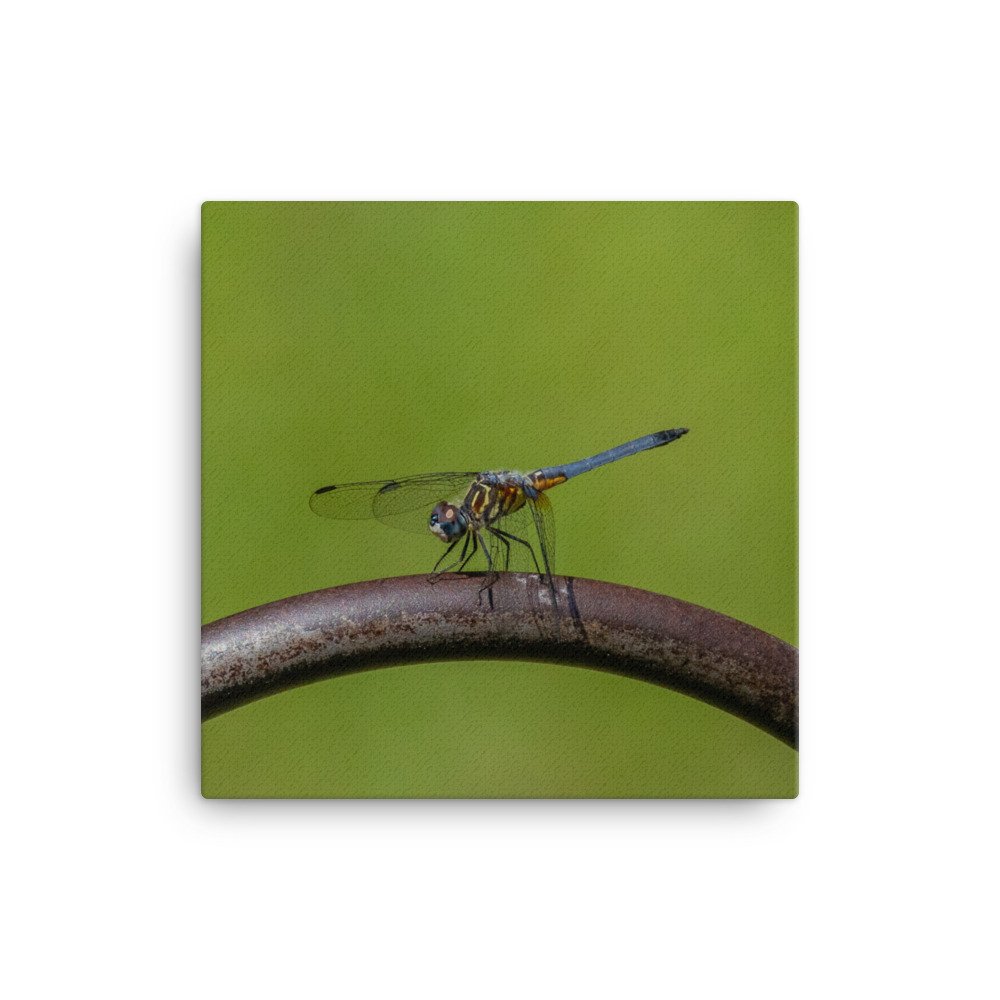 Image 1 of 2
Image 1 of 2

 Image 2 of 2
Image 2 of 2



Canvas - Blue Dasher Dragonfly
from $40.00
The Blue Dasher Dragonfly (Pachydiplax longipennis) is a member of the skimmer family and is the only species in the genus Pachydiplax. It is a common and widespread dragonfly in North America, ranging from British Columbia to Ontario, south to California and Florida, and into Mexico, the Bahamas, and Belize. They are medium-sized dragonflies that have four wings with two noticeable dark streaks in them. Adult males have a chalky, blue color from head to abdomen that ends with a black tip. Their heads contain large eyes capable of seeing almost 360 degrees around and take on a metallic sheen in certain lighting. The females abdomen is stubier and black with yellow stripes along the sides and top and wings that do not contain the aforementioned streaks. Their thorax has yellowish-green striping not seen on adult males. They habitate near still, calm bodies of water, such as ponds, marshes, slow-moving waterways, and ditches where males are usually seen near the water's edge protecting their territory from other males. Herr, the females will lay up to 700 eggs within 35 seconds where they attach to plant matter on the surface of the water. Their life is a process of metamorphosis that begins underwater as a nymph feeding on insects, invertebrates, small fish and tadpoles for up to 2 years before hatching. They're able to live underwater this entire time because their rectum is equipped with gills allowing them to breath underwater. They are very tolerant to low levels of oxygen in the water, which some people think makes their presence an indicator of poor water quality
Size:
Quantity:
Add To Cart
The Blue Dasher Dragonfly (Pachydiplax longipennis) is a member of the skimmer family and is the only species in the genus Pachydiplax. It is a common and widespread dragonfly in North America, ranging from British Columbia to Ontario, south to California and Florida, and into Mexico, the Bahamas, and Belize. They are medium-sized dragonflies that have four wings with two noticeable dark streaks in them. Adult males have a chalky, blue color from head to abdomen that ends with a black tip. Their heads contain large eyes capable of seeing almost 360 degrees around and take on a metallic sheen in certain lighting. The females abdomen is stubier and black with yellow stripes along the sides and top and wings that do not contain the aforementioned streaks. Their thorax has yellowish-green striping not seen on adult males. They habitate near still, calm bodies of water, such as ponds, marshes, slow-moving waterways, and ditches where males are usually seen near the water's edge protecting their territory from other males. Herr, the females will lay up to 700 eggs within 35 seconds where they attach to plant matter on the surface of the water. Their life is a process of metamorphosis that begins underwater as a nymph feeding on insects, invertebrates, small fish and tadpoles for up to 2 years before hatching. They're able to live underwater this entire time because their rectum is equipped with gills allowing them to breath underwater. They are very tolerant to low levels of oxygen in the water, which some people think makes their presence an indicator of poor water quality
The Blue Dasher Dragonfly (Pachydiplax longipennis) is a member of the skimmer family and is the only species in the genus Pachydiplax. It is a common and widespread dragonfly in North America, ranging from British Columbia to Ontario, south to California and Florida, and into Mexico, the Bahamas, and Belize. They are medium-sized dragonflies that have four wings with two noticeable dark streaks in them. Adult males have a chalky, blue color from head to abdomen that ends with a black tip. Their heads contain large eyes capable of seeing almost 360 degrees around and take on a metallic sheen in certain lighting. The females abdomen is stubier and black with yellow stripes along the sides and top and wings that do not contain the aforementioned streaks. Their thorax has yellowish-green striping not seen on adult males. They habitate near still, calm bodies of water, such as ponds, marshes, slow-moving waterways, and ditches where males are usually seen near the water's edge protecting their territory from other males. Herr, the females will lay up to 700 eggs within 35 seconds where they attach to plant matter on the surface of the water. Their life is a process of metamorphosis that begins underwater as a nymph feeding on insects, invertebrates, small fish and tadpoles for up to 2 years before hatching. They're able to live underwater this entire time because their rectum is equipped with gills allowing them to breath underwater. They are very tolerant to low levels of oxygen in the water, which some people think makes their presence an indicator of poor water quality
